The NVIDIA GeForce GTX 780 Ti Review
by Ryan Smith on November 7, 2013 9:01 AM ESTOverclocking
Finally, let’s spend a bit of time looking at the overclocking prospects for the GTX 780 Ti. Although GTX 780 Ti is now the fastest GK110 part, based on what we've seen with GTX 780 and GTX Titan there should still be some headroom to play with. Meanwhile there will also be the matter of memory overclocking, as 7GHz GDDR5 on a 384-bit bus presents us with a new baseline that we haven't seen before.
| GeForce GTX 780 Ti Overclocking | ||||
| Stock | Overclocked | |||
| Core Clock | 876MHz | 1026MHz | ||
| Boost Clock | 928MHz | 1078MHz | ||
| Max Boost Clock | 1020MHz | 1169MHz | ||
| Memory Clock | 7GHz | 7.6GHz | ||
| Max Voltage | 1.187v | 1.187v | ||
Overall our overclock for the GTX 780 Ti is a bit on the low side compared to the other GTX 780 cards we’ve seen in the past, but not immensely so. With a GPU overclock of 150MHz, we’re able to push the base clock and maximum boost clocks ahead by 17% and 14% respectively, which should further extend NVIDIA’s performance lead by a similar amount.
Meanwhile the inability to unlock a higher boost bin through overvolting is somewhat disappointing, as this is the first time we’ve seen this happen. To be clear here GTX 780 Ti does support overvolting – our card offers up to another 75mV of voltage – however on closer examination our card doesn’t have a higher bin within reach; 75mV isn’t enough to reach the next validated bin. Apparently this is something that can happen with the way NVIDIA bins their chips and implements overvolting, though this the first time we’ve seen a card actually suffer from this. The end result is that it limits our ability to boost at the highest bins, as we’d normally have a bin or two unlocked to further increase the maximum boost clock.
As for memory overclocking, we were able to squeeze out a bit more out of our 7GHz GDDR5, pushing our memory clock 600MHz (9%) higher to 7.6GHz. Memory overclocking is always something of a roll of the dice, so it’s not clear here whether this is average or not for a GK110 setup with 7GHz GDDR5. Given the general drawbacks of a wider memory bus we wouldn’t be surprised if this was average, but at the same time in practice GK110 cards haven’t shown themselves to be as memory bandwidth limited as GK104 cards. So 9%, though a smaller gain than what we’ve seen on other cards, should still provide GTX 780 Ti with enough to keep the overclocked GPU well fed.
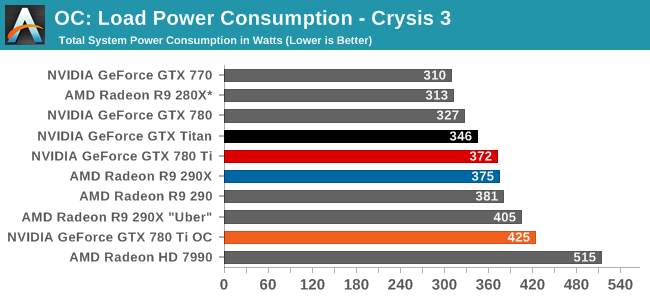
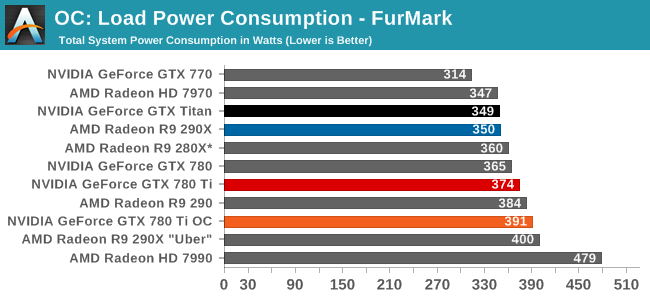
Starting as always with power, temperatures, and noise, we can see that overclocking GTX 780 Ti further increases its power consumption, and to roughly the same degree as what we’ve seen with GTX 780 and GTX Titan in the past. With a maximum TDP of just 106% (265W) the change isn’t so much that the card’s power limit has been significantly lifted – as indicated by FurMark – but rather raising the temperature limit virtually eliminates temperature throttling and as such allows the card to more frequently stay at its highest, most power hungry boost bins.
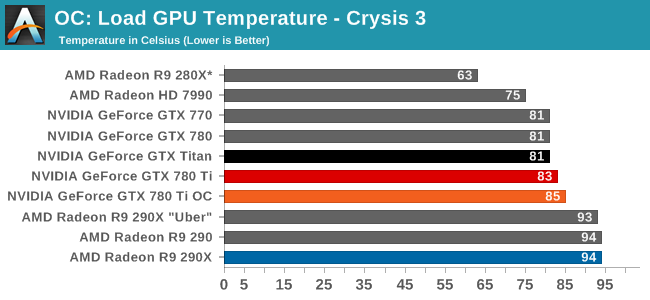

Despite the 95C temperature target we use for overclocking, the GTX 780 Ti finds its new equilibrium point at 85C. The fan will ramp up long before it allows us to get into the 90s.
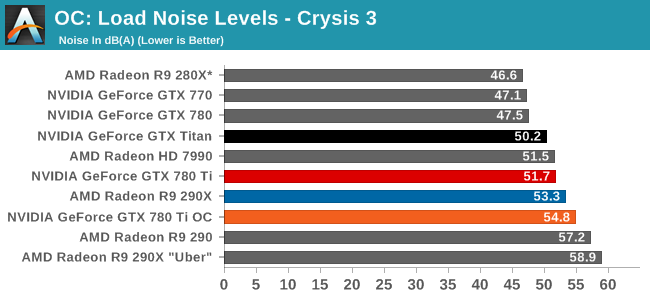
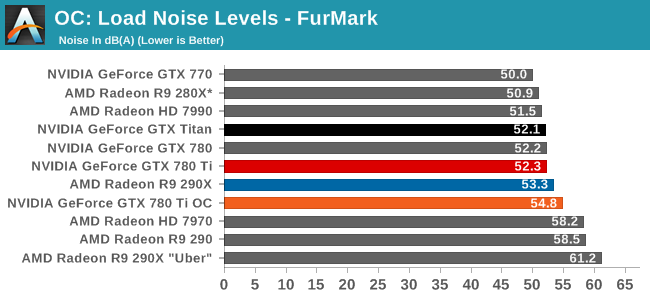
Given the power jump we saw with Crysis 3 the noise ramp up is surprisingly decent. A 3dB rise in noise is going to be noticeable, but even in these overclocked conditions it will avoid being an ear splitting change. To that end overclocking means we’re getting off of GK110’s standard noise efficiency curve just as it does for power, so the cost will almost always outpace the payoff on a relative basis.
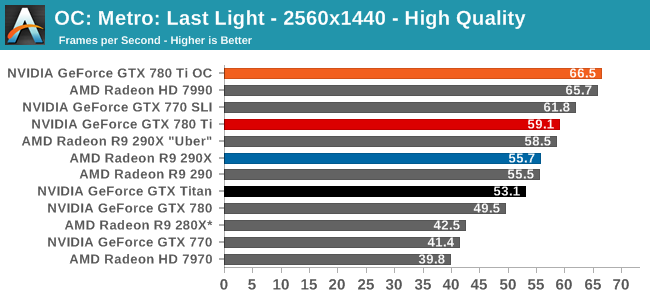
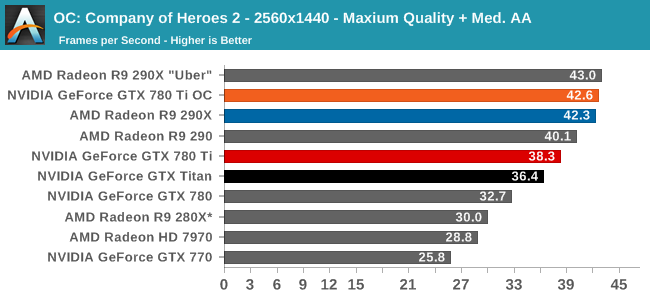
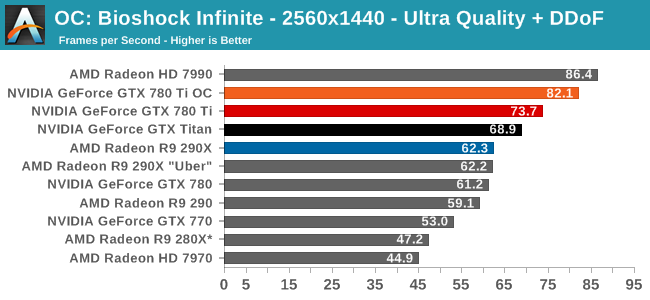
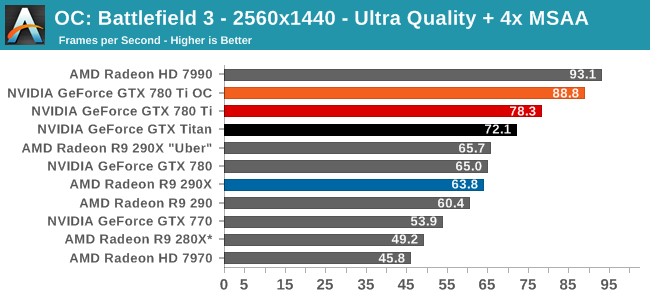
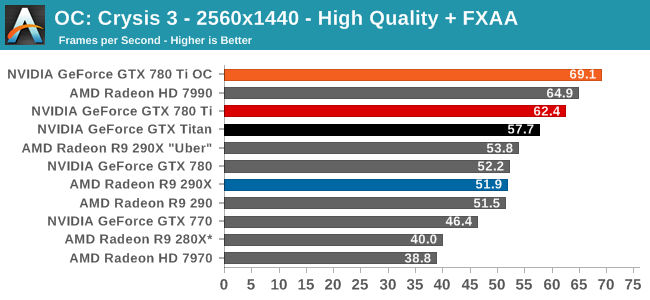
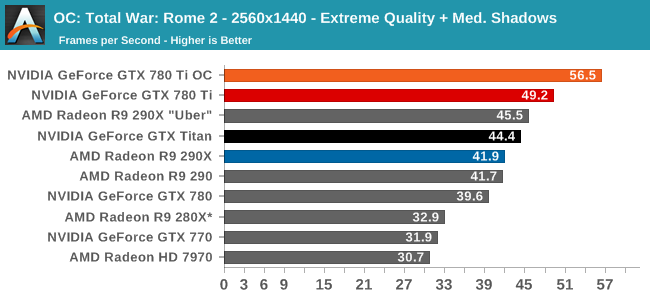
Finally, looking at gaming performance the the overall performance gains for overclocking are generally consistent. Between our 6 games we see a 10-14% performance increase, all in excess of the memory overclock and closely tracking the GPU overclock. GTX 780 Ti is already the fastest single-GPU card, so this only further improves its performance lead. But it does so while cutting into whatever is above it, be it the games where the stock 290X has a lead, or multi-GPU setups such as the 7990.










302 Comments
View All Comments
Filiprino - Thursday, November 7, 2013 - link
And I have to add that with aftermarket coolers the 290X will get better performance, allowing to overclock even more.Here you have only compared the 290X without overclocking, only "Uber mode" which I is not the same as overclocking.
ludikraut - Thursday, November 7, 2013 - link
I'm not really on board with the R9 290X. Seems to me that the performance/overclocking of the 290X is a little sketchy, whereas the results for the 290 appear to be more consistent and for $150 less, much more attractive.Skiddywinks - Thursday, November 7, 2013 - link
I think that sketchiness comes from the fact it gets throttled all the time. With the fan running on a temperature knife edge, the ambient temp and layout of your PC is going to have a massive effect on how well it is going to perform.The 290, as we should all know, had a fan speed boost to try and take on the 780 after the price drop, instead of the targeted 770. Once AMD get around to giving the 290X the same treatment (or, alternatively, we start seeing these after market coolers), I would be willing to bet the 290X will start looking much more promising. Probably still not enough to ruin the 290 as the go-to value high end product, but it will certainly not look as pointless as current reviews and benchmarks have it looking.
madwolfa - Thursday, November 7, 2013 - link
Crysis 3 section has BF3 part pasted in it.ludikraut - Thursday, November 7, 2013 - link
What this review really needs is results for a CF R9 290. Seems to me that a pair of R9 290s will trounce a 780Ti for only $100 more. Actually looking at the overall results and how the R9 290 stacks up, I just don't see being able to justify a $300 premium for the 780ti.l8r)
smartypnt4 - Thursday, November 7, 2013 - link
This. 100% this. They'll do it eventually, but I doubt he had a 2nd R9 290 in time to put those results in.That said, the R9 290X crossfire results make me very, very hopeful for R9 290 performance. A pair of them for $800 would be a steal to get a level of 4K gaming that wasn't available at anything below $1300 previously (2x780), and the 2x290 should even beat dual 780s handily at 4K based on how the 290X does (unless they give a special 780 some of that 7GHz memory).
just4U - Friday, November 8, 2013 - link
From what I've noticed thru the years..with a product launch of this nature Anandtech doesn't rain to much on the featured cards parade. It's the star of the show after all. They get some criticism for that but ah well. They do release updated information and head to head comparison articles after initial launches. Maybe it's just a time thing.
Vorl - Thursday, November 7, 2013 - link
I can't believe that the reviewer is allowed to be so blatantly biased.I suppose they assume most of their audience is too stupid to actually think.. but still. things like this are really making me start to lose respect for a site I have read for years now.
It is so bad, it is almost to the point of leaving and recommending people I talk to/work with look for a less biased site.
nsiboro - Thursday, November 7, 2013 - link
I was initially worried about the wording/flow too but I think Ryan did the right thing.He was comparing 780ti to 780/Titan and only brought up R9-290/X when things mattered.
The take away from this review is that R9-290/X with AIB custom cooler will beat 780-Ti and reclaim the crown for AMD.
The R9-290 non-X with AIB custom cooler (when it gets released) will surely get an Editor's Award.
Vorl - Thursday, November 7, 2013 - link
I could see your point if he hadn't blatantly said "don't but the 290". Not "look forward to after marked cooling".They downplayed 4k, and the games that the 290 series did better in, and use much stronger words in the few areas that the Ti did better in.
It's also funny how they downplay the price for a minimal improvement in speed. I remember in past reviews that a price difference like that would have made a huge difference in recommendation no matter things like noise levels.